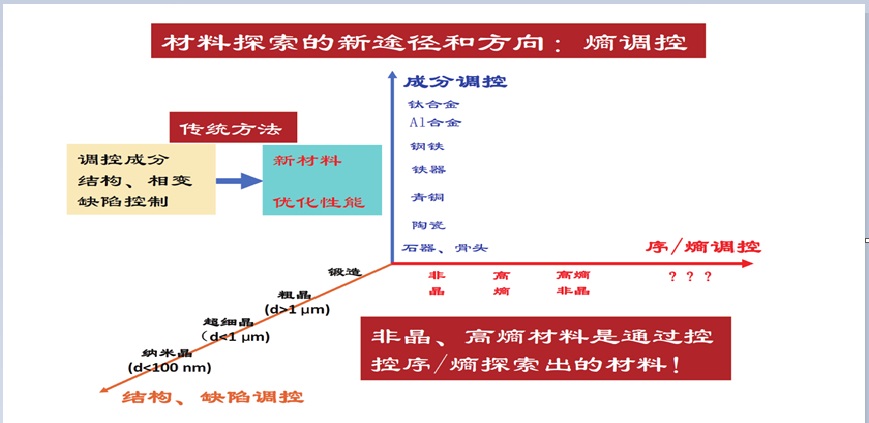[1] ANDERSON P W. Through a glass lightly [J]. Science, 1995, 267: 1615-1616.
[2] BOURHIS E L. Glass: mechanics and technology [M]. Weiheim: WILEY-VCH Inc., 2008.
[3] 干福熹. 丝绸之路上的古代玻璃研究[M]. 上海: 复旦大学出版社, 2011.
[4] 郭贻诚, 王震西. 非晶态物理学[M]. 北京: 科学出版社, 1984.
[5] 汪卫华. 非晶态物质的本质和特性[J]. 物理学进展, 2013, 33: 177-351.
[6] 汪卫华. 金属玻璃简史[J]. 物理, 2011, 40: 701-709.
[7] ZALLEN R. The physics of amorphous solids [M]. New York: Wiley, 1983.
[8] BRENNER A, RIDDELL G. Deposition of nickel and cobalt by chemical reduction [J]. J Res Nat Bur Stand, 1947, 39: 385-395.
[9] BRENNER A, COUCH D E, WILLIAMS E K. Electrodeposition of alloys of phosphorus with nickel or cobalt [J]. J Res Nat Bur Stand, 1950, 44: 109-122.
[10] BUCKEL W, HILSCH R. Einfluss der kondensation bei tiefen temperaturen auf den elektrischen widerstand und die supraleitung fur verschiedene metalle [J]. Z Phys, 1954, 138: 109-120.
[11] KLEMENT W, WILLENS R, DUWEZ P. Non-crystalline structure in solidified gold-silicon alloys [J]. Nature, 1960, 187: 869-870.
[12] TURNBULL D. Under what conditions can a glass be formed [J]. Contem Phys, 1969, 10: 473-488.
[13] ASHBY M F. Materials selection in mechanical design [J]. 3rd ed. Amsterdam: Elsiver, 2005.
[14] BROWN L M, PAIS A, PIPPARD S B. Twentieth century physics [M]. Bristol: Institute of Physics Publishing, 1995.
[15] JOHNSON W L. Thermodynamic and kinetic aspects of the crystal to glass transformation in metallic materials [J]. Prog Mater Sci, 1986, 30: 81-134.
[16] SURYANARAYANA C. Mechanical alloying and milling [J]. Prog Mater Sci, 2001, 46: 1-184.
[17] BAI H Y, MICHAELSEN C, BORMANN R. Inverse melting in a system with positive heat of formation [J]. Phy Rev B, 1997, 56: 11361-11364.
[18] CHEN H S, HAEMMERLE W H. Excess specific heat of a glassy Pd 0.775 Cu 0.06 Si 0.165 alloy at low temperature [J]. J Non-Cryst Solids, 1972, 11(2): 161-169.
[19] KUI H W, GREER A L, TURNBULL D. Formation of bulk metallic glass by fluxing [J]. Appl Phys Lett, 1984, 45: 615-616.
[20] JOHNSON W L. Bulk glass-forming metallic alloys: science and technology [J]. MRS Bull, 1999, 24: 42-56.
[21] WANG W H. The elastic properties, elastic models and elastic perspectives of metallic glasses [J]. Prog Mater Sci, 2012, 57: 487-656.
[22] LEWANDOWSKI L L, WANG W H, GREER A L. Intrinsic plasticity or brittleness of metallic glasses [J]. Philo Mag Lett,
2005, 85(2): 77-87.
[23] LIU Y H, WANG G, PAN M X, et al. Super plastic bulk metallic glasses at room temperature [J]. Science, 2007, 315: 1385.
[24] DEMETRIOU M D, LAUNEY M E, GARRETT G, et al. A damage-tolerant glass [J]. Nature Mater, 2011, 10: 123-128.
[25] SILVEYRA J M, FERRARA E, DALE L, et al. Soft magnetic materials for a sustainable and electrified world [J]. Science, 2018, 362: eaao0195.
[26] LI M X, ZHAO S F, LU Z, et al. High temperature bulk metallic glasses developed by combinatorial methods [J]. Nature, 2019, 569: 99-103.
[27] GIBNEY E. How to build a Moon base [J]. Nature, 2018, 562: 474-478.



